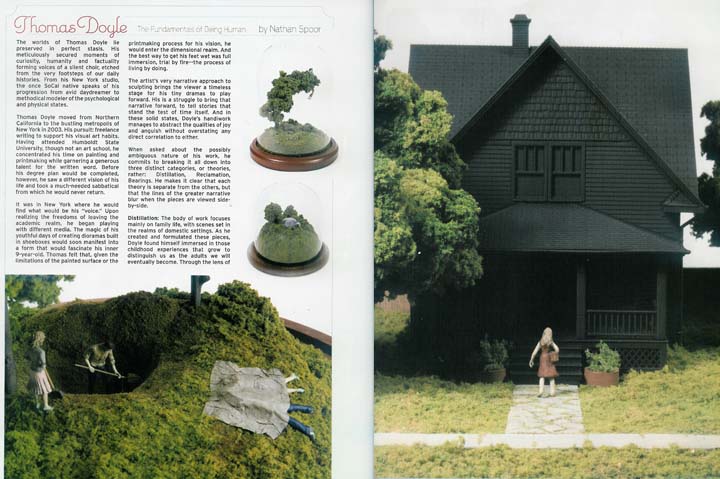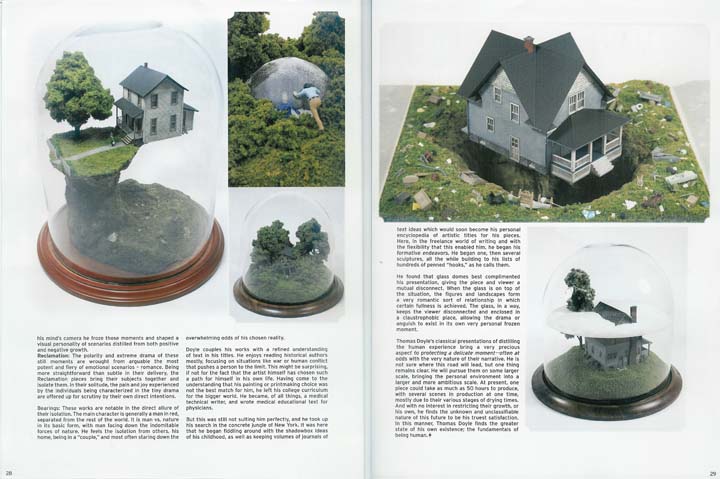


THOMAS DOYLE
THE FUNDAMENTALS OF BEING HUMAN
By Nathan Spoor
The worlds of Thomas Doyle lie preserved in perfect stasis. His meticulously
secured moments of curiosity, humanity and factuality forming the voices
of a silent choir, etched from the very footsteps of our daily histories.
From his New York studio, the Michigan native speaks of his progression
from avid daydreamer to methodical modeler of the psychological and
physical states.
Thomas Doyle moved from Northern California to the bustling metropolis
of New York City in 2003. His pursuit: freelance writing to support his
visual
art habits. Having attended Humboldt State University, he concentrated
his time on painting and printmaking, while garnering a generous talent
for the
written word. Before completing his degree plan, however, he saw a different
vision of his life and took a much-needed sabbatical from which he would
never return.
It was in New York where he found what would be his “voice”.
Upon realizing the freedoms of leaving the academic realm, he began playing
with different media. The magic of his youthful days of creating dioramas
built in shoeboxes would soon manifest into a form that would fascinate his
inner nine year old. Thomas felt that, given the limitations of the painted
surface or the printmaking process for his vision, he would enter the dimensional
realm. This new direction would incorporate his fascination with the written
word, and he began keeping volumes of journals of text ideas that would soon
become his personal encyclopedia of artistic titles for his pieces. Here,
in the freelance world of writing and with the flexibility that this enabled
him, he began his formative endeavors. He began one, then several sculptures,
all the while building lists of hundreds of penned “hooks”, as
he lovingly refers to them. He was on his way, ready to step into the new
version of himself. And the best way to get his feet wet was full immersion – trial
by fire – the process of living by doing.
Doyle’s process is not composed of the struggles of digging for ideas
or pleading for images to come to him. Rather, ideas for his work comes
from the active process of sketching constantly, allowing the image to
appear
and be refined over time. Once the idea is present and understood he moves
quickly to modeling the idea within the immediate and fairly permanent
nature of the plaster stage.
The artist’s very narrative approach to sculpting brings the viewer
a timeless stage for his tiny dramas to play forward. His is a struggle to
bring that narrative forward, to tell stories that stand the test of time
itself. And in these solid states, Doyle’s handiwork manages to abstract
the qualities of joy and anguish without overstating any direct correlation
to either.
When asked about the possibly ambiguous nature of his work, he commits
to breaking it all down into three distinct categories – or theories,
if you will: Distillation, Reclamation, and Bearings. He makes it clear
that each theory is separate from the others, but that the lines of the
greater
narrative blur when the pieces are viewed side-by-side.
Distillation
The body of work focuses mainly on family life, with scenes set in the
realms of domestic settings. As he created and formulated these pieces,
Doyle found
himself immersed in those childhood experiences that grow to distinguish
us as the adults we will eventually become. Through the lens of his mind’s
camera he froze those moments and shaped a visual personality of scenarios
distilled from both positive and negative growth.
Reclamation
The polarity and extreme drama of these still moments are wrought from
arguably the most potent and fiery of emotional scenarios: Romance. More
straightforward
than subtle in their delivery, the Reclamation pieces bring their subjects
together and isolate them. In their solitude, the pain and joy experienced
by the individuals being characterized in the tiny drama are offered up
for scrutiny by their own direct intentions.
Bearings
These works are notable in the direct allure of their isolation. The main
character is generally a man in red, separated from the rest of the world.
It is man vs. nature in its basic form, with man facing down the indomitable
forces of nature. He feels the isolation from others, his home, being in
a “couple,” and is often found reveling in the overwhelming
odds of his chosen reality.
Doyle couples his works with a refined understanding of text in his titles.
He enjoys reading historical authors mostly, focusing on situations like
war or human conflict that can push a person to the limit. This might be
surprising, if not for the fact that the artist himself has chosen such
a path for himself in his own life. Having come to the understanding that
his
painting or printmaking choice was not the best match for him, he left
his college curriculum for the bigger world. He became, of all things,
a medical
technical writer, and wrote medical educational text for physicians.
But this did not suit him to perfection, so he continued his search in
the concrete jungle of the Big Apple. It was here that he began fiddling
around
with the shadowbox ideas of his childhood. Through his curious explorations,
he found that glass domes best complimented his presentation, giving the
piece and viewer a mutual disconnect. When the glass is on top of the situation,
the figures and landscapes form a very romantic sort of relationship in
which a particular fullness is achieved. The glass, in a way, keeps the
viewer
disconnected and enclosed in a claustrophobic space, allowing the drama
or anguish to exist in its own very personal frozen moment.
Thomas Doyle’s classical presentations of distilling the human experience
bring a very precious aspect to protecting a delicate moment – often
at odds with the very nature of their narrative. He is not sure where this
road will lead, but one thing remains clear. He will pursue them on a larger
stage, bringing the personal environment into a larger and more ambitious
scale. At present, one piece could take as long as 50 hours to produce,
with several scenes in production at any given moment, mostly due to their
various
stages of drying times. And with no interest in restricting their growth,
or his own, he finds the unknown and unclassifiable nature of this future
to be his truest satisfaction. In this manner, Thomas Doyle finds the greater
state of his own existence: the fundamentals of being human.

THOMAS DOYLE:
THE FUNDAMENTALS OF BEING HUMAN
Feature by Nathan Spoor
Hi Fructose Magazine
Vol.11
To view online features, order this issue or subscribe, please click here.